About 1,000 km off the western coast of Ecuador, a Galapagos Island tour offers a thoroughly unique experience. The only water park is the ocean, and the only rides have sails or two wheels. There is no place like them anywhere else on Earth. The Galapagos Islands off the coast of Ecuador could be among the last truly unexplored frontiers on the planet. The forbidding volcanic islands are part of Ecuador's national park system, and much of their land area is completely off-limits to tourists and explorers. Groups and tours in the area are confined to no more than twenty visitors under a trained naturalist's guidance.
In concert with the Charles Darwin Foundation for the Galapagos, the Ecuadorian government keeps a close eye on the fragile ecosystem of the islands, preserving it in as natural a state as possible for future generations. The Galapagos Islands were made famous by Charles Darwin and helped him form his theories of evolution. They have been called 'the lands where time stood still', and you'll easily believe that when you visit.
 A giant tortoise in the Galapagos Islands. [CC] credit.
A giant tortoise in the Galapagos Islands. [CC] credit.The volcanic islands are home to creatures seen nowhere else in the world – the enormous Galapagos turtles, cormorants, marine and land iguanas, and many other indigenous species to the Galapagos. The flora and fauna of the Galapagos Islands are the main attraction for visitors, who especially appreciate the fearlessness of the local wildlife.
Because of the long years of isolation and preservation, the indigenous creatures have no inbred fear of man, and it's not uncommon for visitors to find themselves literally nose to nose with a seal pup in the water or pausing on a bike trail to allow a turtle to cross the road.
A visit to the Galapagos Islands is an extraordinary adventure. While it is possible to find lodging on one of the islands and simply stay there, most visitors book a guided tour with one of the many companies that employ trained naturalist guides. Tours generally run 5-14 days, and most of that time will be spent traveling between islands on a ship or yacht. The accommodations range from berth space on a large sailboat to suites on luxury yachts. All tours are led by a trained naturalist who will introduce the islands to visitors – and vice versa. A well-trained and knowledgeable naturalist guide is the key to a never-to-be-forgotten adventure for the entire family. If you're planning a family trip to the Galapagos, be certain that you book your tour with a company specializing in family tours. Having a guide who enjoys working with and relating to children can turn your 'tour' into an adventure of enchantment that your children will remember for the rest of their lives.
The Islands
The Galapagos archipelago consists of 13 larger islands, 6 smaller ones, and 107 rocks and islets. The largest of these, Isla Isabela, is also one of the two youngest islands, created by the merging of six volcanoes. The Galapagos Islands are located at one of the volcanic 'hot spots' of the world, where the underlying mantle plate's movement causes volcanic action. The most recent eruption occurred in 2005 on Isla Isabela (Albemarle).
Most Galapagos tours include a stop at Isabela, the location of the third-largest human settlement in the islands and home to Darwin finches, land iguanas and Galapagos tortoises. Other important islands in the chain include Santa Cruz Island, the Charles Darwin Research Center's home, and the Galapagos National Park Service headquarters.
The largest city in the islands, Puerto Ayora, is also located on Santa Cruz. Visitors may see the GNPS tortoise breeding center, where young tortoises are hatched and raised before being reintroduced into the wild. The island is famous for its lava tunnels and for the large tortoise population.
Baltra, home to one of the two airports in the Galapagos and an entry point for most visitors. Many visitors will meet up with their naturalist guides there and board the ships or yachts to visit the rest of the islands.
Darwin Island is one of the smallest of the archipelago, just under half a mile in area. Since there are no dry landing spots at Darwin, a stop there means jumping out of the boat offshore and wading in. That's fine, though, since the biggest attractions at Darwin Island aren't on land – they're under the sea in the amazing variety of marine life that you can see on a snorkeling jaunt.
Espanola is the oldest island in the chain, estimated to be about 3.5 million years old. It is also the southernmost of the islands, and its remoteness has kept it secluded and isolated for centuries. There are two visitor sites on Espanola. Gardner Bay has a wonderful beach that offers both swimming and snorkeling activities, opening the wide world of the underwater to view. Punta Suarez offers one of the most eclectic collections of native species found anywhere in the islands. Visitors may see lava lizards, Hood mockingbirds, Galapagos finches, Blue-footed and Nazca Boobies and Marine Iguanas. The island's cliffs also offer one of the best runways for the Waved Albatross, and visitors can sit and watch them fly from the beaches below.
When to go
January through April is the 'hot season' on the Galapagos Islands when frequent afternoon thundershowers make the islands greener and the land birds most active. The ocean is generally warmer during these months, making it an ideal time for snorkeling and swimming. The rest of the year is the 'cool season', and the land mammals are more active. It's an excellent time to observe sea birds' mating rituals and enjoy sunny days with little chance of rain.